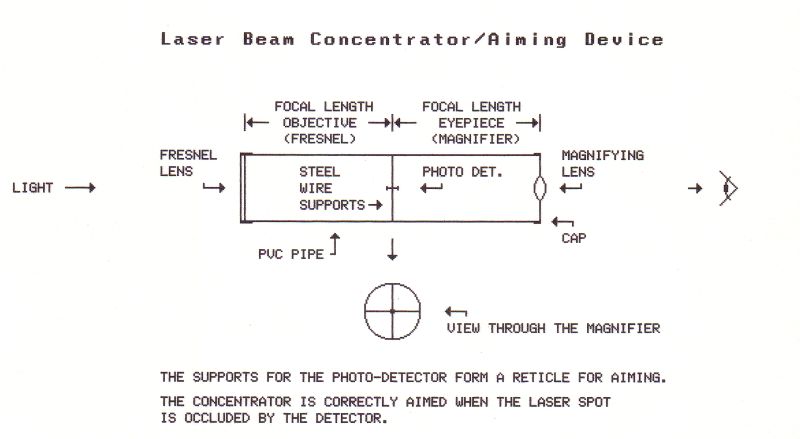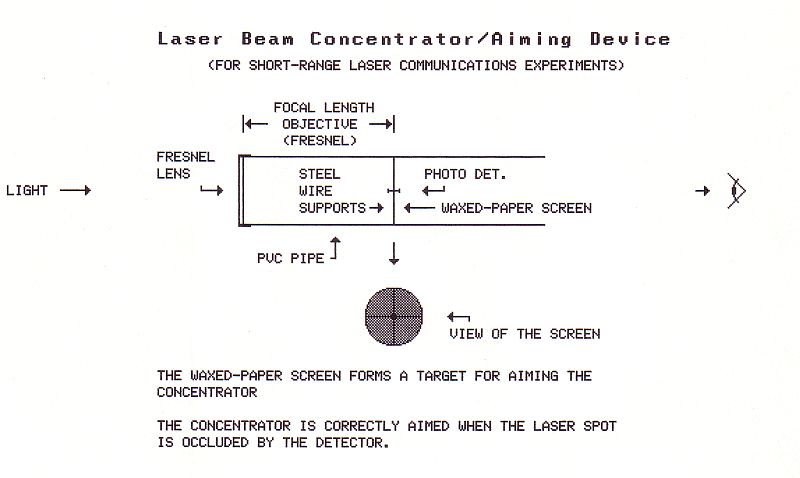Laser Beam Concentrator/Aiming Device
Laser beam concentrator increases photodetector sensitivity for laser communication experiments.
Warning: This device is meant to be used with a visible class-IIIa (<5 mW) laser at a distance.
Do not look at any higher-powered laser with this device!
Do not view any laser through this device at a distance less than 1/4 mile (400m)!
(A modification of the concentrator for use at short ranges appears below.)
Schematic
(not to scale)

- Almost any pipe diameter or combination of lenses can be used for construction of the concentrator. The only rules are:
- The length of the pipe should equal the focal length of the objective (Fresnel lens) plus the focal length of the eyepiece (magnifying lens).
- The photo detector should be placed on the focal plane of the objective - placement at the precise focal point is not strictly necessary.
- The eyepiece lens should be placed at the other end of the pipe - the objective and the eyepiece will thus share a common focal plane.
- The length of the pipe should equal the focal length of the objective (Fresnel lens) plus the focal length of the eyepiece (magnifying lens).
- The larger the objective diameter, the greater the laser beam concentration (gain).
- Magnification power (this is not the same as gain) equals objective focal length divided by eyepiece focal length, thus, the shorter the focal length of the eyepiece, the higher the magnification power of the aiming device. High power is not necessarily an advantage. Long focal-length lenses (both objective and eyepiece) and low magnification powers (<5) will produce the best results. Note that a "lens" of infinite focal length, i.e., no lens at all, can be used for the eyepiece. In that case the viewing hole (the hole in the end cap where the magnifying lens would have been mounted) should be made small to minimize parallax error.
- The focal length of the lenses can be determined by focusing the light from a distant source (such as a street light) through the lens onto a sheet of white paper; when the light source is in focus, measure the distance from the sheet to the lens; that distance is the lens's focal length.
- Fresnel lenses are available from Scientifics Online, Anchor Optics, 3Dlens.com (cheap) and many other sources. At the time of this writing, a 11" x 11" (27.5cm x 27.5cm) Fresnel lens, focal length about 28" (70cm), was available here.
- Almost any lens you happen to have around, including another Fresnel (credit card magnifier), will work as the eyepiece. However, small diameter/short focal length (< 2.5cm) lenses should be avoided. Such lenses carry a risk of eye damage from the concentrated laser beam! The lens from an ordinary 3" (7.5cm) hand magnifier, focal length about 7" (17.5cm), works well with a 10" (25cm) diameter pipe and the 11" x 11" Fresnel lens mentioned above. The total length of the concentrator/aiming device would then be about 35" (88cm). Magnification power would be 4 in this case. All Electronics has some small surplus magnifying lenses cheap. You should be able to find one that will work as an eyepeice. Click here .
- The body of the concentrator can be fabricated with almost any tubing available, oatmeal boxes, coffee cans, carpet tubing, stovepipe or PVC pipe. Click here to see a version built with irrigation pipe. Click here for one made with tin cans and a glass lens.
- Paint the inside of the pipe black.
- As noted in the schematic above, the photo-detector mounting supports form the reticle, or 'cross-hairs', of the aiming device. Stiff piano wire, copper wire, small diameter dowel rod or threaded rod can be used to support the detector.
- The completed concentrator can be mounted on a tripod or other support of your own design. The mount/support should be adjustable, but be stiff enough to stay in place after the concentrator is aimed.
- The concentrator is aimed by looking through the eyepiece lens and pointing the assembly until the observed laser spot is occluded (blocked) by the photo-detector. The scene projected through the magnifier will appear upside down. If the objective, reticle and eyepiece have been correctly placed during construction, minimal parallax error will be observed, that is, movement of the observer's head will produce minimal movement of the laser spot relative to the reticle. Final fine adjustment of the concentrator is made by observing the output of the photodetector and carefully pointing for maximum signal output.
Warning: This device is meant to be used with a visible class-IIIa (<5 mW) laser at a distance.
Do not look at any higher-powered laser with this device!
Do not view any laser through this device at a distance less than 1/4 mile (400m)!
Short Range Laser Beam Concentrator
This version is safe for use at short distances.
Schematic
(not to scale)

- The short-range version of the concentrator is constructed the same as the long-range version above except that the magnifying lens is left off. A piece of waxed-paper, cut to the same size as the pipe and with a hole cut in the middle to accomodate the photo-detector, is glued to the photo-detector supports. The waxed-paper acts as a ground-glass screen on which the laser beam is projected by the objective (Fresnel) lens. As with the long-range version above, the concentrator is pointed so as to cause the projected laser spot to be occluded by the photo-detector. No parallax error will be seen.
- The waxed-paper screen serves to scatter and attenuate the laser beam, making it safe to use at short range without fear of eye damage. The short range version of the concentrator should be used when the laser is positioned closer than 1/4 mile (400m), but will also work quite well at longer ranges, especially at night.